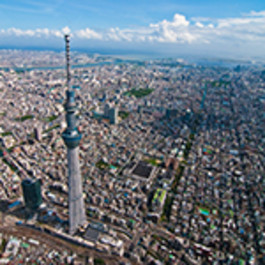A God's-Eye View

Our Tokyo 13 mission completed, yesterday Karen and I were two thirds of the way up the world’s tallest tower, the Tokyo Skytree. At 634 meters (2080 feet) the Skytree is only exceeded by Mt Fuji in the hazy distance. The highest point visitors are permitted to ascend (by an elevator that travels at 10 meters/second) is 451.2 meters (1480 feet). From our glassed in vantage point we could look down on the thirteen million people that live within Tokyo’s immediate city limits—but beyond them as far as the eye can see is the megapolis that makes Tokyo and vicinity the largest urban sprawl on the planet (37 million people). Towering glass and steel corporate offices, surrounded by tiny two-story Ma-and-Pa stores with their cramped upstairs residences, intersected by freeways and alleyways, the criss-cross of mass transit (emphasis on the mass), in the midst of which is the thick green folliage of the Imperial Palace where live an emperor and empress—this is Tokyo, with nearly one out of every three people in Japan (and one out of every 189 people on earth) living beneath the Skytree’s gaze. But what is the God’s-eye view? “For the eyes of the LORD run to and fro throughout the whole earth” (2 Chronicles 16:9). Beyond Tokyo, as His eye sweeps over Osaka and Seoul and Beijing and Singapore and Perth and Calcutta and Istanbul and Soweto and Nairobi and Moscow and Prague and London and Sao Paulo and Mexico City and Toronto and New York and Houston and Santa Fe and Seattle and Benton Harbor, beyond “the smoke of a thousand villages—villages whose people are without Christ, without God, and without hope in the world” (Robert Moffat)—what is His God’s-eye view of this civilization? When He gazes through the mortar and mud, the steel and glass, the tin and cardboard behind which are huddled the masses of earth, what does God see? For “the eyes of the LORD are in every place, keeping watch on the evil and the good” (Proverbs 15:3). We see a world separated by its radical diversities, segregated by its racial/socio-economic/geographic divides. But the clearest and most penetrating vision belongs to the God atop the cross who still so loves the world (John 3:16), who still these millennia later sends His friends and followers into it, all of it (Matthew 28:19). The truth is God stills sends missionaries—student missionaries, lifelong missionaries, short-term missionaries, volunteer missionaries—to the furthest reaches of civilization. The crying needs we witnessed in the Land of the Rising Sun (where 1/100 of 1% are members of our community of faith) have convinced me that the day of missionaries is hardly past. In fact I believe the day of missionaries has a new dawning for this generation at this critical time. “And I heard the voice of the Lord saying, ‘Whom shall I send, and who will go for us?’ Then I said, ‘Here I am! Send me’” (Isaiah 6:8, 9). Today when you overhear His voice asking that very same question, I hope the Spirit of God will embolden you to make that very same reply.